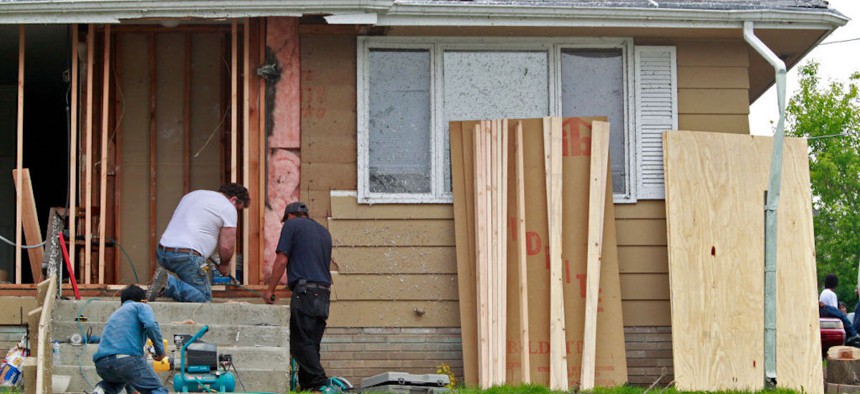How one city funds climate resilience, a dollar at a time

Marlin Levison/Star Tribune via Getty Images
With $1 collected from every electric and gas bills each month, Minneapolis plans to weatherize residents’ homes, install rooftop solar on commercial buildings and build electric vehicle charging stations.
Minneapolis introduced an ambitious Climate Equity Plan that calls for 100% carbon neutrality by 2050, and it’s found a creative way to get there.
The Minneapolis City Council approved a Climate Legacy Initiative last month that would add a small fee to community members’ utility bills to fund housing weatherization projects that reduce residents’ energy use.
The initiative, signed by Minneapolis Mayor Jacob Frey, estimates that monthly electric and gas bills for residential, commercial and industrial energy users will increase on average by $1 starting in January, according to an Oct. 19 city announcement. Those extra dollars, officials said, will supply $10.2 million each year to support the city’s climate resilience work for the next 10 years.
Utility companies Xcel Energy and CenterPoint Energy will collect and pay the additional $1 as a franchise fee to the city government. The city in turn will use the revenue from the rate increase to fund insulating, electrifying and retrofitting Minneapolis buildings to improve their energy efficiency. Building owners and residents can apply for retrofits through programs like Minneapolis’ Green Cost Share, and projects will be completed by professionals from the utility companies.
For homeowners, the utility fee could make “a big difference at a fraction of the cost,” said Jennifer Amann, a senior fellow at the research nonprofit American Council for an Energy-Efficient Economy’s buildings program.
In fact, according to a 2022 estimate by the city, 66% of Minneapolis homes had poor attic insulation, and 38% of homes had inadequate wall insulation. Families in nonweatherized homes pay an average of $2,037 for energy each year, but sealing and insulation upgrades under the Climate Legacy Initiative could help reduce those costs by $350.
Weatherization also makes structures more resilient to climate change, Amann said. Sealing gaps where air could leak in or out of homes or commercial buildings and installing an insulating barrier makes them “more like a thermos,” which helps "minimize temperature exchange.”
Take, for example, a power outage during the summer. If “the building has been [weatherized], it can maintain a cooler temperature for much longer,” Amann said. “That’s so important for [city managers] to consider as we’re going to be facing increasing episodes of extreme weather.”
Other upgrades under the Climate Legacy Initiative include installing electric cold-climate heat pumps, said Patrick Hanlon, the city’s deputy commissioner of sustainability, healthy homes and environment. The funds will also go toward building electric vehicle charging stations and installing rooftop solar panels, among other improvements, on commercial buildings.
The city will prioritize weatherization retrofits in marginalized communities, where the housing stock is most likely in need of insulation and energy-efficient electricity due to historic underinvestment, Hanlon said. Data from the city’s health department and pollution control agency, for example, helped officials identify which communities, or green zones, fit into that category.
In addition to building climate resilience, Hanlon said the Climate Legacy Initiative will help build the city’s clean energy workforce. For the first year of the program, the Star Tribune reported, about half of funds will support the hiring and training of a local green workforce. Officials hope to add 1,000 jobs by 2030, training workers that have expertise in energy auditing, solar power, HVAC and district energy systems.
A larger workforce will help the city scale up its weatherization and electrification targets, Hanlon said, which is necessary if Minneapolis wants to achieve its goal of weatherizing 40,000 homes by 2040.
“The way [cities] can get more weatherization done is to … provide some incentive to consumers so that they understand what the benefits are and why it’s important to do these [climate resilience] projects,” Amann said.
Minneapolis isn’t the only city leveraging energy bills for climate action funds. Earlier this year, another Minnesota city, Eagan, approved implementing a franchise fee on utility companies to finance sustainability projects. Hanlon said St. Louis Park and Hopkins are also supporting similar efforts.
Elsewhere, the San Diego City Council in 2021 approved the use of franchise fees to build its climate equity fund that will finance projects like planting trees and building parks. And in Iowa, the Des Moines City Council voted to extend its franchise agreements with a local utility company, which will help the city track its use of renewable energy to inform its clean energy implementation.






